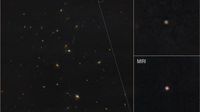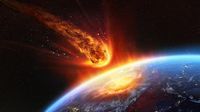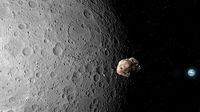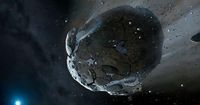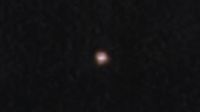Astronomers Catch Glimpse Of City-Killer Asteroid Before It Disappears
Astronomers have successfully captured images of the "city-killer" asteroid 2024 YR4, just before it disappears from view until 2028. This asteroid, which was previously thought to have a 3.1% chance of striking Earth in December 2032, has had that possibility eliminated following further observations, according to NASA.
The asteroid, measuring between 174 and 220 feet in diameter, is roughly the size of a 10-story building and has been dubbed a "city-killer" due to its potential to cause significant damage if it were to collide with a populated area. Kelly Fast, a planetary defense officer at NASA, explained that the asteroid is currently being closely monitored as it approaches its disappearance in mid-April 2025.
NASA's Center for Near Earth Object Studies utilized the James Webb Space Telescope (JWST) to obtain images of the asteroid, which is the largest and most powerful telescope ever launched into space. Fast stated, "Its unique elongated orbit takes the asteroid around the sun and into Earth's vicinity before it ventures far out between the orbits of Mars and Jupiter and out of sight." The asteroid was initially discovered on December 27, 2024, by astronomers using the ATLAS telescope at the University of Hawaii.
Recent infrared observations from the JWST indicate that the asteroid is larger than initially estimated. Earlier calculations suggested a diameter of about 40 meters (131 feet), but new measurements show it is actually about 60 meters (200 feet) across. This size means that if 2024 YR4 were to strike Earth, it would unleash an explosion 500 times more powerful than the atomic bomb dropped on Hiroshima.
Despite the alarming initial estimates, scientists have ruled out any chance of 2024 YR4 hitting Earth, but there remains a 1.7% probability of it colliding with the moon in 2032. Davide Farnocchia, a navigation engineer with NASA's Jet Propulsion Laboratory, emphasized the importance of continued monitoring, saying, "We don't want to take any chances." The asteroid is currently projected to have a 1.1% chance of striking Earth on December 22, 2047.
In February 2025, global space agencies had warned of the potential for a collision with Earth, which led to increased scrutiny and observations of the asteroid. During this period, NASA made the decision to grant an international team of astronomers access to the JWST to accurately measure the asteroid's size and understand the potential consequences of a collision.
Dr. Andy Rivkin, an astronomer from Johns Hopkins University and principal investigator for the Webb Director's Discretionary Time program, remarked on the significance of these observations. He noted that the thermal properties of 2024 YR4 differ from those of larger asteroids, likely due to its rapid spin and a surface composed of larger rocks rather than fine-grained sand. Rivkin stated, "We found that the thermal properties of 2024 YR4, in other words, how quickly it heats up and cools down, and how hot it is at its current distance from the sun, are not like what we see in larger asteroids."
As scientists continue to gather data on 2024 YR4, they also express interest in the implications for future asteroid monitoring and planetary defense. Rivkin believes that understanding how to observe potentially dangerous objects is crucial for humanity's survival. He explained, "All together, we have a better sense of what this building-sized asteroid is like. This will help us determine the best approach to use during a more urgent observing program should another asteroid pose a potential impact threat in the future."
The asteroid's trajectory brings it close to Earth every four years, and while the immediate threat has been ruled out, the possibility of a collision with the moon remains a concern. If 2024 YR4 were to strike the moon, it would allow scientists to observe a crater forming in real-time, providing invaluable data about lunar geology.
NASA's ongoing efforts to track and study asteroids like 2024 YR4 underscore the importance of planetary defense initiatives. As the agency continues to refine its observations and risk assessments, the data gathered from the JWST and other telescopes will aid in preparing for future potential threats.
In summary, while 2024 YR4 has caused concern due to its size and initial impact probabilities, ongoing observations have significantly reduced the threat level to Earth. The focus now shifts to understanding the asteroid's characteristics and potential interactions with the moon, as scientists work to enhance our preparedness for any future asteroid encounters.

